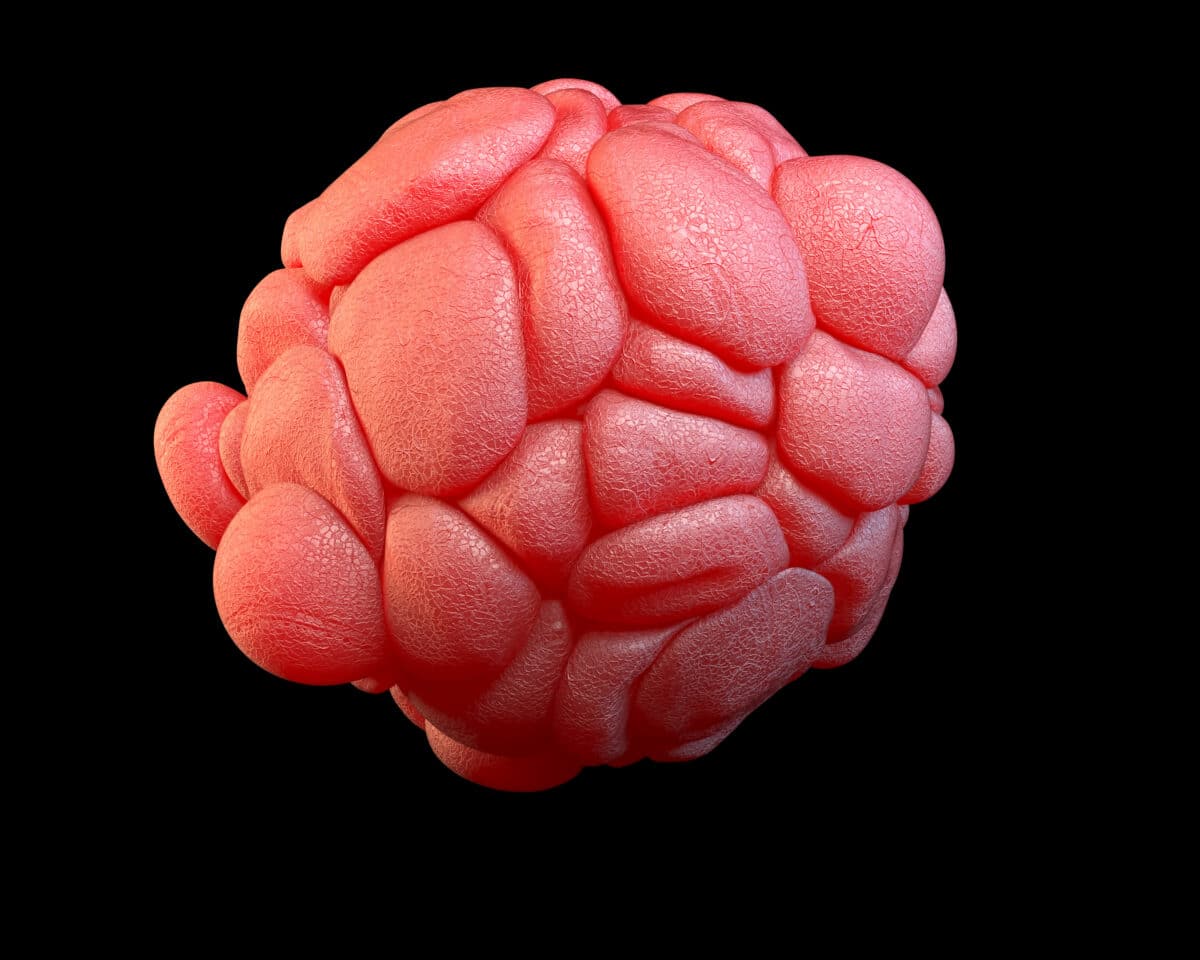
(Image by Shutterstock AI Generator)
In a nutshell
- Drugs processed by the liver can become significantly more toxic to brain cells than when directly exposed to the brain, highlighting the importance of multi-organ testing.
- The diabetes drug troglitazone, when processed by liver cells, affected nearly 7 times more genes and disrupted 10 times more cellular pathways in brain organoids.
- This new testing approach could revolutionize drug safety assessment by catching neurological side effects that traditional animal testing often misses.
BOSTON — Most of us take medications assuming they’ll help without harm. We rarely stop to consider what happens after a pill dissolves — or how our own liver might unintentionally turn a safe drug into something dangerous, especially for our brain.
Now, scientists at Quris Technologies have uncovered evidence that some drugs become significantly more harmful to brain cells after being metabolized by the liver. The findings, published in Biomedicine & Pharmacotherapy, could change how we evaluate drug safety — and explain why some medications cause unexpected neurological side effects that animal testing often misses.
Their target was troglitazone, a diabetes drug that was pulled from the market years ago for causing liver damage.
A Smarter Way to Simulate the Human Body
For their investigation, the team built a cutting-edge laboratory system called BioAI that mimics what happens when drugs travel through the human body — what they describe as “patients-on-a-chip.” They connected miniature versions of human liver and brain tissues — called spheroids and organoids — to study how drugs processed by the liver affect the brain.
What they discovered was startling: when troglitazone was first processed by liver cells, it became dramatically more toxic to brain cells than when it was applied to the brain alone.
“We observed that troglitazone, tested at clinically relevant doses in the Liver+Brain model, caused a significantly greater reduction in cell viability compared to similar treatments in the Brain-only model,” the researchers write in their paper.
This could help explain why some dangerous side effects slip through animal testing, which doesn’t always capture how human livers uniquely transform medications into toxic byproducts.

A Closer Look at the Experimental Models
Instead of using flat petri-dish cell layers or animal models, the researchers created 3D mini-organs from human cells. Their liver spheroids included about 2,000 human cells from ten donors, replicating real human liver tissue with functioning metabolic enzymes. The brain organoids were grown from stem cells over several weeks and even produced electrical activity — a sign of working neurons.
By linking the two models together, they discovered troglitazone’s full impact. In the Liver+Brain system, the drug affected 3,941 genes in brain cells. In contrast, only 685 genes were affected when it was applied directly to the brain — nearly a seven-fold difference. Even more striking, it disrupted ten times more biological pathways, especially those involved in brain cell growth and development.
It’s Not All Bad News
Interestingly, not every drug became more dangerous after liver metabolism. Valproic acid, used to treat epilepsy and mood disorders, showed reduced toxicity after liver processing at high doses — demonstrating the complexity of how drugs interact with different organs.
The study also reinforces momentum behind the FDA Modernization Act 2.0, which supports moving away from animal testing and toward more human-relevant methods like this one.
Why This Matters for Patients and Prescribers
The study could have an immediate impact on drug testing and development. It suggests we should pay closer attention to neurological side effects — especially for drugs heavily processed by the liver. And it could help pharmaceutical companies detect brain-related risks before medications ever reach clinical trials.
Traditional safety models have often tested drugs on either isolated cells or animals, missing critical interactions that happen between organs in the human body. By simulating both liver and brain together, the BioAI model catches what others can’t.
In the future, this kind of testing could ensure that what helps one part of the body doesn’t silently harm another.
Paper Summary
Methodology
The researchers created two testing models: a “Brain-only” model using human-induced pluripotent stem cell (iPSC)-derived brain organoids (hiBOs), and a “Liver+Brain” model where drugs were first processed by human liver spheroids (hLiSps) before being applied to the brain organoids. They tested six drugs known to cause neurological side effects, including troglitazone, valproic acid, and others. The liver spheroids were composed of about 2,000 human primary cells, including hepatocytes and other liver cells from 10 different donors. The brain organoids were developed over four weeks through a guided protocol to differentiate iPSCs into neural cells. They verified the functionality of both models through various tests, including protein expression, enzyme activity, and electrical activity in the brain organoids. The researchers applied drugs to the models at clinically relevant concentrations for three consecutive days, then measured cell viability, performed gene expression analysis, and conducted microscopic examinations.
Results
The study found that troglitazone caused significantly greater toxicity in brain organoids when first processed by liver spheroids compared to direct application. This effect was consistent across brain organoids from three different donors and at various stages of development. When examining gene expression, they discovered that liver-processed troglitazone affected 3,941 genes in brain organoids compared to only 685 genes when applied directly—a nearly 7-fold increase. It also impacted 10 times more cellular pathways, particularly those related to cell division and neurogenesis. Interestingly, high-dose valproic acid showed reduced toxicity after liver processing. They confirmed that both cytochrome P450 enzymes and sulfotransferase enzymes in the liver contributed to troglitazone’s increased neurotoxicity through inhibitor studies.
Limitations
The study acknowledged several limitations. The current model lacks a blood-brain barrier component, which would better mimic how drugs move between the bloodstream and brain in humans. The researchers noted that adding a human-derived, functional blood-brain barrier model would improve the system. Additionally, they mentioned that a microfluidic setup connecting the liver and brain compartments would better simulate physiological conditions with controlled flow. The liver spheroids, while functional, may have experienced some cell death during the experimental period, potentially affecting quantification of metabolic capabilities. The study also focused on only six drugs, which limits the generalizability of findings across all medications.
Funding and Disclosures
All authors of the study are employees of Quris Technologies and may hold equity in the company. The research was funded by Quris Technologies. The authors acknowledged support from InSphero AG, Axion Biosystems, Azenta Life Sciences, and Tharkka Corporation for various aspects of the study, including providing liver spheroids, demonstration of equipment, and RNA sequencing services. They also acknowledged support from the Microscopy Core of the Program in Membrane Biology, which is partially supported by a Centre for the Study of Inflammatory Bowel Disease Grant and a Boston Area Diabetes and Endocrinology Research Center Award.
Publication Information
The paper titled “Multi-organ model assessment of neurotoxicity following exposure of liver spheroids to drugs” was authored by Wei Wu, Faiza Anas, Baran Koc, Lipeng Tian, Ryan Hasselkus, Darian Rezania, Sophia Sharareh, Luba Farberov, Dor Zlotnik, Ariel Alon, Guy Tenzer, Isaac Bentwich, and Amir Bein. It was published in Biomedicine & Pharmacotherapy, volume 186, April 2025, article number 118021, and was made available online on April 2, 2025. The article is open access under the CC BY-NC-ND license.








Please leave the mice alone. Thank you.🐭